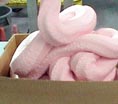 Raise your hand if you ever went to elementary school and it had a cafeteria. Hands down. Raise your hand if you ever went to middle school and it had a cafeteria. Hands down. Raise your hand if you ever went to high school and it had a cafeteria. Note: A diploma is not required to raise your hand. My fellow educated Americans, if you pushed a plastic tray across metal rails and stared down that cafeteria lady in a hairnet, you have been slimed.
Raise your hand if you ever went to elementary school and it had a cafeteria. Hands down. Raise your hand if you ever went to middle school and it had a cafeteria. Hands down. Raise your hand if you ever went to high school and it had a cafeteria. Note: A diploma is not required to raise your hand. My fellow educated Americans, if you pushed a plastic tray across metal rails and stared down that cafeteria lady in a hairnet, you have been slimed.
And not the green gooey funny stuff of Nickelodeon fame. Every kid wanted to get slimed, right? Note: Just in case you want to make a batch for yourself, ahem, for actual children, it is made with Borax, glue, water and some green food coloring. But is it edible? I think not.
Pink is the new green
No my friends, we’re talking about the gross pink-colored strands streaming across mass media that resemble grandma’s wool sweater before her deft fingers knitted one and pearled two. BTW: The sweater is edible. Ask my dog.
Nearly 40 years ago U.S. heath officials approved the use of ammonia in many food products. Yep, the same stuff your mama used to clean the stuck- on crap off linoleum floors has been used to clean your beef, er, lunch.
A mystery no more
So that “mystery meat”, those precious round and oval shaped patties served up with the canned peas and an ice-cream scoop of dehydrated and reconstituted mashed potatoes most likely made its way through the ammonia drive-through before the server slopped it on your plate. This was (is) government subsidized food products at its best.
The so-called “pink slime” is used as filler for ground beef. It is made from fatty trimmings that are more susceptible to contamination than other cuts of beef. To make it safer to eat, the trimmings are sprayed with ammonium hydroxide – ammonia mixed with water – to remove pathogens such as salmonella and E.coli. Tuck a napkin under my chin and pass the ketchup!
“This is not a health issue,” said Bill Marler, a prominent food safety lawyer. “This is an ‘I’m grossed out by this’ issue.”
…and it’s everywhere!
But don’t swear off the meat just yet. Ammonia has been used for years in leavening agents for baked goods and as an acidity controller in cheese and some chocolate products. Shut the front door, you say! Let’s be realistic. If we knew the scope of the additives and preservatives in our everyday food and avoided eating them we’d all look like runway models.
Food scientists say “pink slime” is made up of nitrogen and hydrogen, occurs naturally in plants, animals, water, air, and in some foods, including milk. Yes, my poop occurs naturally as well but I’m not adding it to my chocolate pie. If you didn’t see the movie, The Help, go rent it or read the book to fully appreciate this reference.
You’ve graduated in adulthood. Put whatever you want on your tray. Who wants a burger with those fries? Hands down. Bon Appetit!




